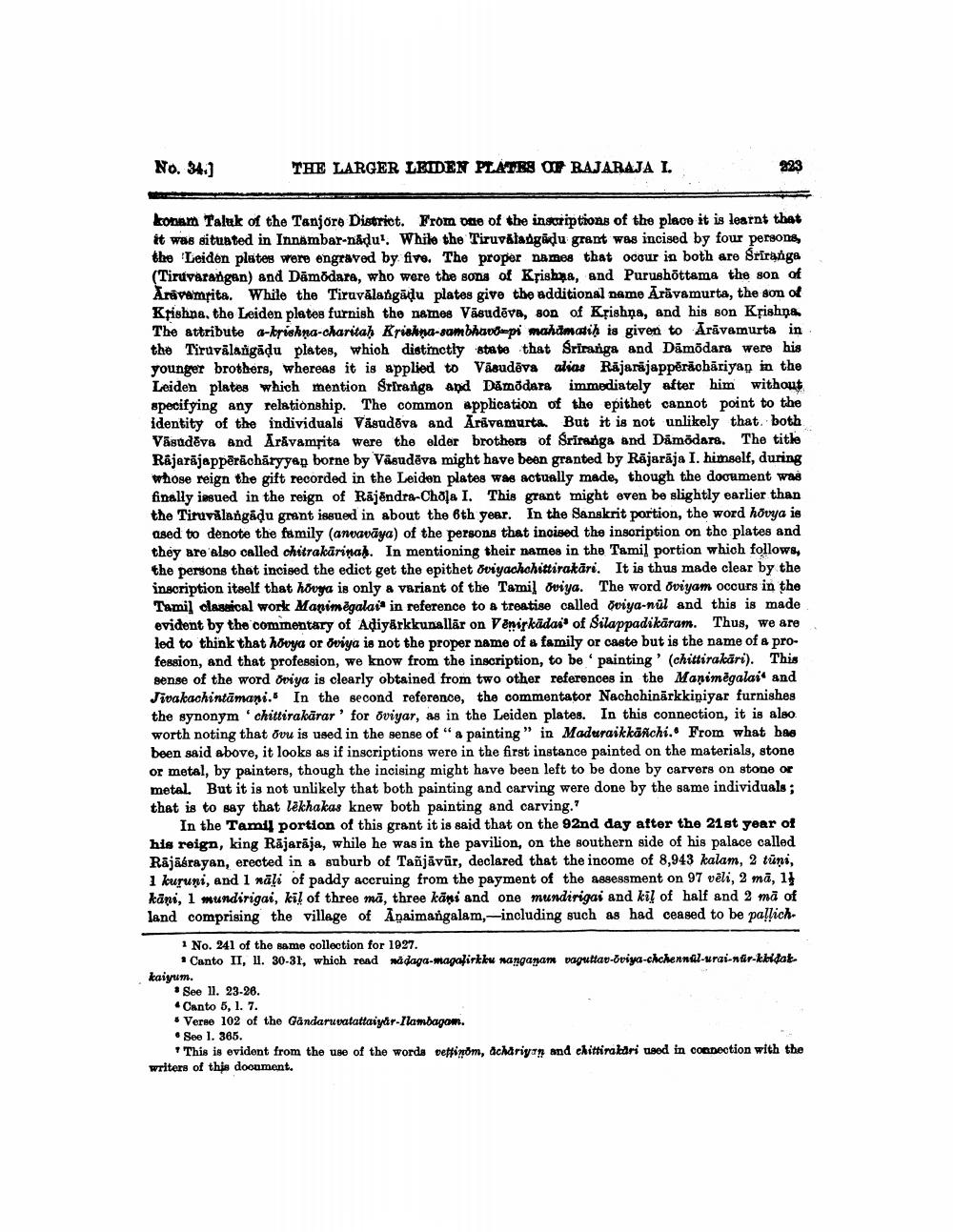________________
No. 34.)
THE LARGER LEIDEN PLATES OF RAJARAJA I.
223
konam Taluk of the Tanjore District. From date of the inscriptions of the place it is learnt that it was situated in Innambar-nadu'. While the Tiruvălangādu grant was incised by four persons, the 'Leiden plates were engraved by five. The proper names that ocour in both are Sriranga (Tiruvarangan) and Damodara, who were the sons of Krishona, and Purushottama the son of Arivamrita. While the Tiruvālangādu plates give the additional name Arāvamurta, the son of Krishna, the Leiden plates furnish the names Vāsudēva, son of Křishna, and his son Kșishna The attribute a-krishna-charita) Krishna-sambhavdepi mahdmatiḥ is given to Arāvamurta in the Tiruvālangādu plates, which distinctly state that Sriranga and Damodara were his younger brothers, whereas it is applied to Vāsudēva alias Rajarajapperácbariyan in the Leiden plates which mention Sriranga and Damodara immediately after him without specifying any relationship. The common application of the epithet cannot point to the identity of the individuals Väsudova and Arāvamurta. But it is not unlikely that both Vāsudēva and Arávampita were the elder brothers of Sriranga and Dämödare. The title Rajarajappērācharyyap borne by Väsudēva might have been granted by Rajaraja I. himself, during whose reign the gift recorded in the Leiden plates was actually made, though the document was finally insued in the reign of Rajendra-Chðla I. This grant might even be slightly earlier than the Tiruvalangadu grant issued in about the 6th year. In the Sanskrit portion, the word hovya is ased to denote the family (anavāya) of the persons that inoised the inscription on the plates and they are also called chitrakärinal. In mentioning their names in the Tamil portion which follows, the persons that incised the edict get the epithet Oviyachohittirakāri. It is thus made clear by the inscription itself that hovya is only a variant of the Tamil Oviya. The word oviyam occurs in the Tamil classical work Manimegalai in reference to a treatise called oviya-nül and this is made evident by the commentary of Adiyarkkunallar on Venirkādas of Silappadikäram. Thus, we are led to think that hovya or Oviya is not the proper name of a family or caste but is the name of a profession, and that profession, we know from the inscription, to be painting' (chittirakäri). This sense of the word oviya is clearly obtained from two other references in the Manimegalai and Jivakachintāmani.In the second reference, the commentator Nachohinärkkiniyar furnishes the synonym chittirakärar' for Oviyar, as in the Leiden plates. In this connection, it is also worth noting that ovu is used in the sense of " a painting" in Maduraikkästchi.. From what has been said above, it looks as if inscriptions were in the first instance painted on the materials, stone or metal, by painters, though the incising might have been left to be done by carvers on stone or metal. But it is not unlikely that both painting and carving were done by the same individuals; that is to say that lēkhakas knew both painting and carving.'
In the Tamil portion of this grant it is said that on the 92nd day after the 21st year of his reign, king Rājarāja, while he was in the pavilion, on the southern side of his palace called Rājāsrayan, erected in a suburb of Tañjāvūr, declared that the income of 8,943 kalam, 2 tuni, 1 kusuni, and 1 nāļi of paddy accruing from the payment of the assessment on 97 vēli, 2 ma, 11 kāni, 1 mundirigai, kil of three mā, three kāxi and one mundirigai and kil of half and 2 mă of land comprising the village of Agaimangalam,-including such as had ceased to be paļļich
1 No. 241 of the same collection for 1927.
Canto II, II. 30-31, which read mädaga-magalirkku nanganan vaputtav-Oviya-chchennul-urai-nair-khidat kaiyum.
• See 11. 23-26.
Canto 5, 1. 7. • Verne 102 of the Gandaruvatattaiyar-Hambagow.. • See 1. 365.
* This is evident from the use of the words bettinom, achariyar and chittiralari uod in connection with the writers of this document.




